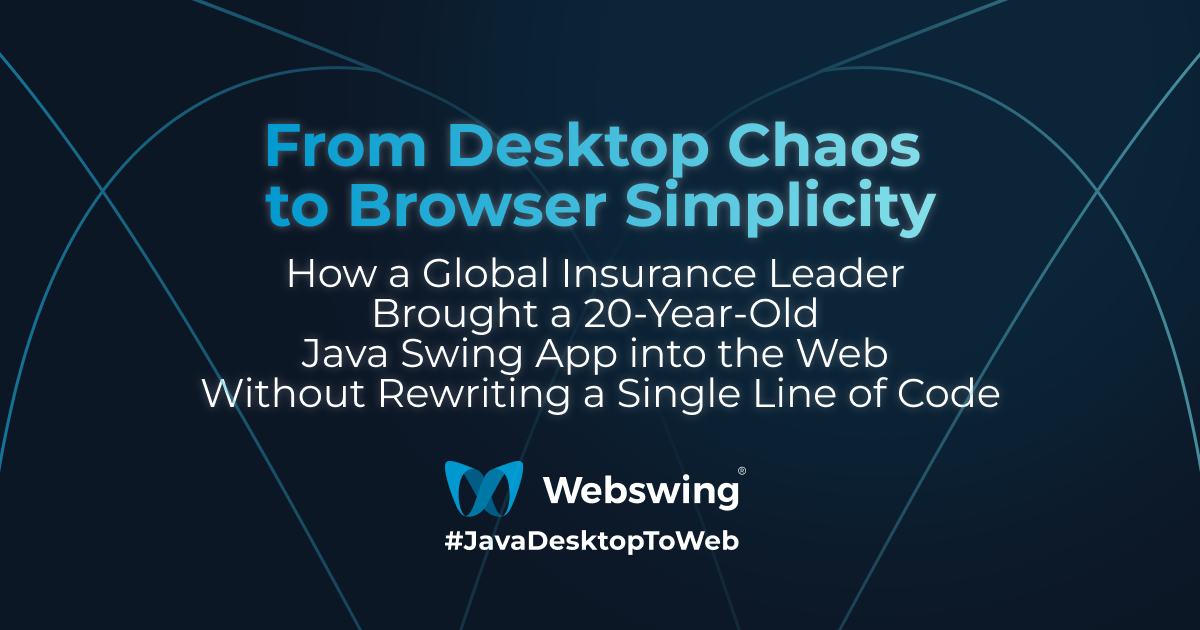How a Global Insurance Leader Brought a 20-Year-Old Java Swing App into the Web Without Rewriting a Single Line of Code.
TLDR;
To give 15,000 staff in 30 countries browser access to a 20-year-old Java Swing app, a global insurer skipped the risky rewrite and ran it with Webswing’s Cluster Engine. Deployed across Europe, Asia and America with Kubernetes autoscaling and latency-based routing, the app kept its familiar UI while IT gained SSO, centralized updates, and observability via Prometheus/Grafana. Results: support tickets down 80%, releases cut from days to ~20 minutes, annual support spend reduced by hundreds of thousands, and ROI in 8 months without changing a line of code or paying for VDI.

When one of the world’s largest insurance companies needed to give 15,000 employees across 30 countries access to its mission-critical Java Swing application, they faced a hard choice: Rewrite everything for the web or find a smarter way.
The rewrite option meant years of work, high risk, and millions in cost. Instead, the IT team discovered that Webswing’s Cluster Engine could deliver the same rich application in a web browser without changing the source code.
What followed was one of the most cost-effective modernisation projects in the company’s history.
Before: A Legacy System Slowing Down a Global Business
The application had been running successfully for two decades. But over time, the cracks began to show:
- Local installations everywhere - hundreds of versions across different operating systems and security policies.
- Upgrades took days, as each release had to be distributed, tested, and fixed separately.
- IT support was overwhelmed, resolving thousands of tickets yearly - from Java version conflicts to broken installs.
- High total cost of ownership: maintaining the desktop setup cost between €0.75 - 1.5M per year, mostly for internal support.
For a company that lives on risk management, this setup has become the biggest risk of all.
The Decision: Run Java Swing in the Browser
The customer decided to deploy the application using Webswing Cluster Engine, a platform which provides the underlying orchestration and scalability capabilities.
To effectively support a large global user base of approximately 15,000 active users, the solution was deployed across three strategic regions: Europe, Asia, and America. Leveraging Kubernetes with dynamic, on-demand horizontal scaling, the infrastructure automatically adjusts resources based on real-time traffic and workload.
A latency-based DNS routing strategy ensures that users are directed to the nearest regional cluster, minimizing response times and improving overall performance. This architecture enables:
- Seamless distribution of user traffic
- High availability and resiliency across regions
- Optimized latency for the best possible user experience globally.
Reliability and Risk Mitigation
With thousands of simultaneous users, resilience was critical. Webswing’s Cluster Engine addressed that through:
- Automatic failover: Stateless Cluster Servers recover sessions instantly on another node.
- Scalable load: Session Pools scale horizontally, or automatically via Kubernetes.
- Central security: unified SSL termination and single sign-on instead of unmanaged desktop credentials.
- Monitoring integration: REST API feeds real-time metrics into Prometheus and Grafana dashboards.
For the first time, the IT team had full observability of who was using what, where, and how - across the entire global deployment.
The Business Impact
Within months of going live, the results were measurable:
KPI: Support tickets
Before: ~6,000 / year
After Webswing: ⬇ 80%
—
KPI: Software updates
Before: Days
After Webswing: 20 minutes
—
KPI: Annual support costs
Before: €1M+
After Webswing: ⬇ by hundreds of thousands
—
KPI: User satisfaction
Before: Slow and outdated
After Webswing: Fast and reliable
—
On the financial side, the company achieved an ROI within 8 months - mainly by cutting endpoint maintenance and eliminating the need for VDI software such as Citrix.
A Project That Changed More Than the Interface
“From the employee’s perspective, nothing changed - the app looks exactly the same. From IT’s perspective, everything changed.” - Lead Architect, Global Insurance Company
The project showed that modernisation doesn’t always mean rewriting. By keeping what worked and modernising only the delivery layer, the company turned a heavy legacy system into a cloud-era service - secure, scalable, and cost-efficient.
The Outcome
Today, thousands of employees log in daily through their browsers to use the same Java application that once lived only on their desktops. It’s centrally updated, monitored, and globally available with the same reliability and business logic that made it critical in the first place.
What used to be a liability has become an asset again - proof that the right architecture can turn old software into modern infrastructure.
—
If this story sounds like your challenge, let’s talk! 👉 Schedule a call or 👉contact us and we’ll help you map your fastest path from legacy desktop application to a web browser.

